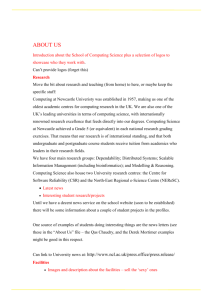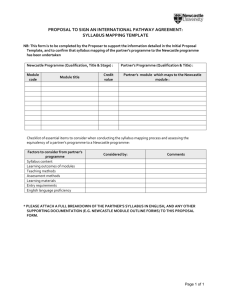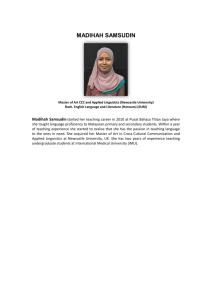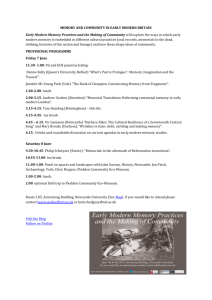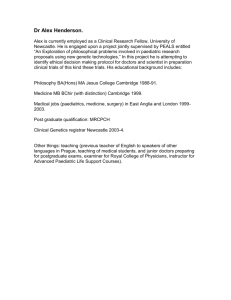Patient safety in health care professional educational curricula: Examining the learning experience
advertisement
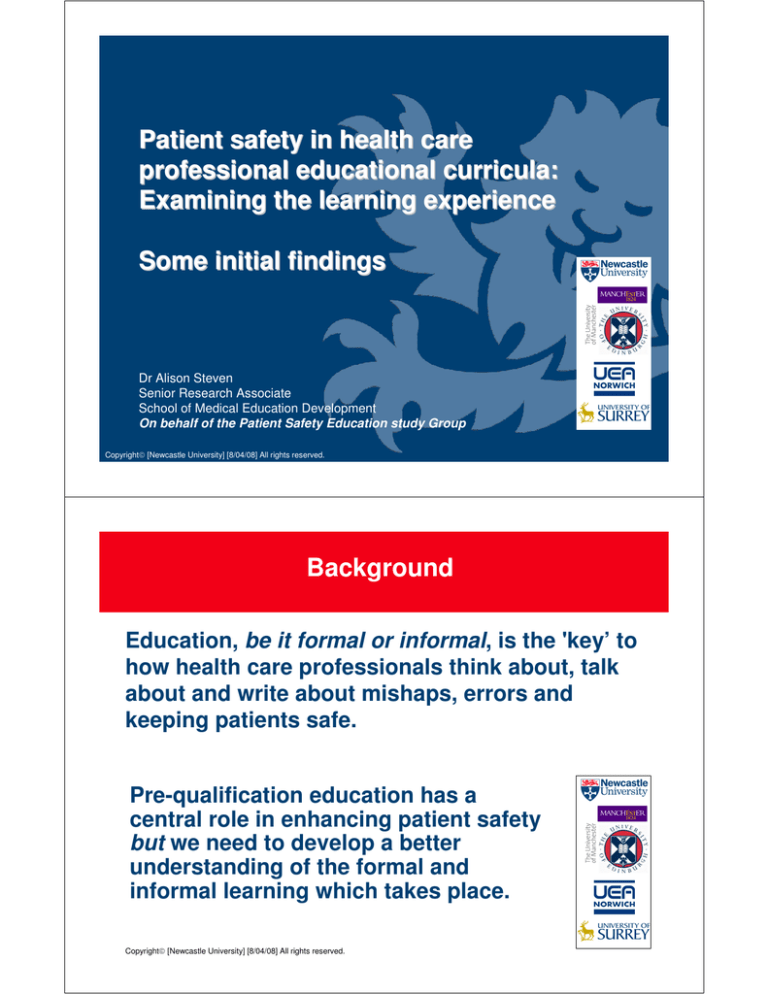
Patient safety in health care professional educational curricula: Examining the learning experience Some initial findings Dr Alison Steven Senior Research Associate School of Medical Education Development On behalf of the Patient Safety Education study Group Copyright [Newcastle University] [8/04/08] All rights reserved. Background Education, be it formal or informal, is the 'key’ to how health care professionals think about, talk about and write about mishaps, errors and keeping patients safe. Pre-qualification education has a central role in enhancing patient safety but we need to develop a better understanding of the formal and informal learning which takes place. Copyright [Newcastle University] [8/04/08] All rights reserved. The study NPSA funded Two and a half years 5 partner institutions exploring undergraduate education for 4 health care professions : Medicine, Nursing, Physiotherapy, Pharmacy Newcastle University (Revd Dr Pauline Pearson - PI) (Dr Alison Steven – Lead researcher) University of East Anglia (Professor Amanda Howe) University of Edinburgh (Professor Aziz Sheikh) University of Manchester (Dr Darren Ashcroft) University of Surrey (Professor Pam Smith) Copyright [Newcastle University] [8/04/08] All rights reserved. The study aim To study the formal and informal ways pre-qualification students from a range of healthcare professions learn about keeping patients safe from errors, mishaps and other adverse events (broadly known as Patient Safety). Copyright [Newcastle University] [8/04/08] All rights reserved. Theoretical framework Knowledge contexts ( Stewart 2006 Drawn from Eraut 1994 ) Academic context Theories and models, views and debate Experts validate knowledge Professional Knowledge Organisational context How it is learned Development and implementation of policy How it is used Validated by public debate Practice context Action – doing, experience and knowing Validated by personal judgement Stewart J. Asking for senior intervention: conceptual insights into the judgement of risk by doctors . PhD thesis, Newcastle University, Newcastle, UK, 2006. Copyright [Newcastle University] [8/04/08] All rights reserved. The study design Phased by context: •1 Academic context (Course content as planned and delivered) • *Part 1 Curriculum analysis and exploration (13 courses)* • Part 2 focusing down on 8 case study courses •2a Organisational context (Influences on courses and practice) •2b Practice context (The cultures to which students are exposed) Copyright [Newcastle University] [8/04/08] All rights reserved. Phase 1 : ‘Academic context’ (Course content as planned, delivered and received) 1a) Analyse for ‘intentions’ (Education as planned) 1b) Decide on number of ‘case studies’ (max.8) 1) Collect course documents (approx. 13 courses) 1.1) Interview key informants (up to approx. 26) 3) Compare (1st time) 3b) Undertake focus groups: Students, Patients involved in education, Newly Qualified Staff. 3a) Develop questions for focus groups 5) Use analyses to develop questions and areas for attention in phase 2b 4a) Compare (2nd time) 2) Undertake observations of teaching in academic and practice settings (Education as delivered) Up to approx . 32 - 4 per course) 2a) Analyse for ‘culture’ and influences on translation of intended curriculum. 4) Feed back into cultural analysis 3c) Analyse for views and opinions of PS education (Education as received) ‘practice based case studies’ Phase 2a: ‘Organisational contexts’ (Influences on courses and practice) 6a) Collect organisational documentation from practice settings (guidelines, protocols) 6b) Collect policy documents from professional bodies (policies, recommendations) 6d) Analyse for underlying organisational ethos 6c) Undertake interviews in relation to organisational and practice contexts. (e.g. Managers, Risk managers, Audit and quality leads) Phase 2b: ‘Practice contexts’ (How PS is undertaken in day to day working: the cultures to which students are exposed) Outcomes Detailed understanding of • a range of PS curricula • the ways in which curricula are translated and interpreted in academic and practice contexts, • organisational influences, • cultural factors influencing translation and interpretation of curricula, Everyday practicesPS practice. 9) Invite participants at each collaboration site to feedback presentations of findings. For respondent validation and refinement of analysis. 7b) Analyse for espoused notions and perceptions of PS practice, policy and education . 7a) Undertake focus groups in practice contexts (Staff including where possible those newly qualified) Compare 8b) Analyse for Patient Safety in practice 8a) Undertake observations of practice context (Maximum 25 days in total) Copyright [Newcastle University] [8/04/08] All rights reserved Who and where Nursing Pharmacy Sunderland Northumbria Medicine Physiotherapy Newcastle Newcastle Lead Lead site site Nursing Pharmacy Medicine Edinburgh Edinburgh Nursing Patient Patient Safety Safety Study Study Sites Sites University University of of Medicine East East Anglia Physiotherapy Anglia Nursing Medicine Pharmacy Red = Case study sites Manchester Manchester Surrey Surrey Copyright [Newcastle University] [8/04/08] All rights reserved Curriculum analysis: Documents collected Course / site Documents Medicine C Handbooks years 1-5 Curriculum mapping to Tomorrows Doctors IPE Medicine B Degree programme handbook Personal and professional development handbooks 1-4 Terminal outcomes grid Medicine A Electronic Medical Curriculum Medicine D Validation documents Student handbook Paper for GMC Nursing D Validation documents Student handbooks Concept maps (paper and electronic) Nursing E Validated curriculum submission document Student handbook Module handbooks (9) Nursing A Overall programme handbook Course handbooks (21) (3 others not available) Course overviews Nursing B Programme specification Module handbooks from website Learning and Teaching Strategy 2004-7 Pharmacy D On line prospectus Unit outlines and learning outcomes (electronic) Placements Induction Handbook (electronic) Lecture notes (electronic) Pharmacy C Accreditation document RPSGB Module handbooks Programme handbooks years 1-4 Website outlines Pharmacy B Web based course description Module descriptors Physio D Revalidation submission 2001 Student handbook years 1, 2 and 3 Placement educators’ handbook Physio B Programme specification / course handbook Module descriptors Supplementary document presented at validation Website outlines Review of PBL cases Learning agreement 2005/6 Website Web based course structure and outcomes Unit documents on Blackboard Website: course description Programme specification 2006 Student recruitment and admissions information sheet Copyright [Newcastle University] [8/04/08] All rights reserved Findings Curriculum analysis : Exploring the micro Specific words and concepts: Adverse events, Critical incidents Error Failures Harm Mishaps Mistakes Near misses Negligence Risk (risk assessment) Safety (safety cycles) Safe practice Serious events Significant events Copyright [Newcastle University] [8/04/08] All rights reserved Findings Curriculum analysis : Exploring the micro Courses Medicine (/4) A C Nursing (/4) B D Tot Mean A B 2 7 13 3.2 0 0 6 2 19 4.7 2 2 0.5 9 11 2.8 10 10 2 Pharmacy (/3) E D Physiotherapy (/2) B D Tot Tot. Tot Mean C B D Tot Mean Mean 0 0 15 1 4 20 6.9 0 33 1 7 1.8 0 0 0 7 2 1 3 0.7 21 7 0 43 0 0 0 0 0 2 1 1 2 0.5 1 1 0.3 0 14 2.5 0 0 1 1 0.3 0 11 5 1.2 0 0 1 2 0.6 0 7 2 4 1 2 0.5 1 1 0.3 19 63 15 74 18.1 13 31 10 13 Words Adverse 4 Critical Incidents Error 7 10 1 1 Failure Harm Mistakes Near misses 3 Negligence 1 1 Safe 26 9 9 Serious Signif. events 2 Risk 14 5 6 2 8 6 33 27 14 3 4 1 15 3 7 0 13 18 31 199 15 1 1 0.2 0 0 0 0 0 1 1 3 0.7 0 0 0 0 0 3 31 56 14 36 9 14 4.8 3 13 10 10 6 4 4 2 9 11 117 5.5 Copyright [Newcastle University] [8/04/08] All rights reserved Findings Curriculum analysis : Exploring the meso Medicine / 4 Nursing / 4 Physiotherapy / 2 Pharmacy / 3 Total Courses Topics Risk assessment A C 4 1 Communication 8 Patient handling 1 4 B 2 D Total Mean A 5 1.25 4 18 4.5 1 2 0.5 Infection control 0 0 Medicines /prescribing/ dispensing/ administering 11 2 3 8 24 6 Blood 4 2 1 1 8 2 B E D 1 3 4 8 16 2 3 1 2 4 5 3 3 Copyright [Newcastle University] [8/04/08] All rights reserved 5 2 Total Mean C B D 4 2 1 3 5 1.25 2 12 3 8 1 2 11 16 4 4 4 1 Total 6 9 D 1 5 6 1 0.5 27 4 6 3 20 2 3 1 1 0 0 2 0 43 Mean B 0 1 Total Mean 1 3 33 0.5 9 52 17.3 0 0 92 0 0 0 0 12 Findings Curriculum analysis : Exploring the meso Personal and professional development and skills 1. Management of self and others to facilitate safe systems of working practice 2. Clinical judgement 3. Competence in the safe and effective application of a range of skills (including communication) 4. Risk assessment, tools and prevention 5. Implementation of safe, effective (evidence based) and efficient treatment Organisational structures and processes 6. Clinical governance including audit, risk, patient safety, error reporting 7. Compliance with health and safety procedures / legal requirements / regulations /ethical principles 8. Threats to safety / causes of error Copyright [Newcastle University] [8/04/08] All rights reserved Findings Curriculum analysis : Exploring the macro Overarching dimensions: Clinical skills •issues about procedures, use of equipment, interpretation (closely linked to decision making), communication with patients (incorporating complaints, explanations, apology, openness and respect) and dealing with contingencies. Prescribing •linked to key words in the vocabulary used in thinking about patient safety – adverse, effective, safe, error, harm - and also considering both the behaviour and its function. Copyright [Newcastle University] [8/04/08] All rights reserved Findings Curriculum analysis : Exploring the macro Overarching dimensions: The individual, • their actions or omissions and decisions, and their relationship with the health care system and its assumptions and responses to error or accident. Ethics and the law, • incorporating the balance of benefit and harm, autonomy and risk. Finally there is a dimension which balances patient and professional, and their expectations and choices. Copyright [Newcastle University] [8/04/08] All rights reserved Issues arising from this data set Limitations of data Definitions of ‘patient safety’ Curriculum delivery Professional vocabularies Copyright [Newcastle University] [8/04/08] All rights reserved Next steps Part of a much larger study Some of the issues highlighted are explored in subsequent data collection Study ongoing Due to finish Dec 2008 Copyright [Newcastle University] [8/04/08] All rights reserved Dr Alison Steven Senior Research Associate School of Medical Education Development The Medical School University of Newcastle Framlington Place Newcastle upon Tyne NE2 4HH Tel 0191 246 4527 Alison.steven@ncl.ac.uk http://psafety.ncl.ac.uk On behalf of the Patient Safety Education study Group



